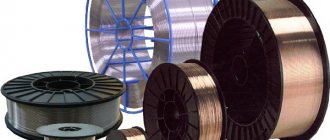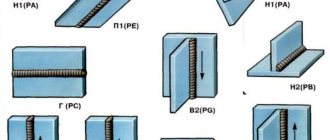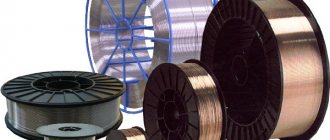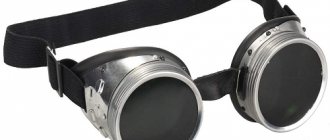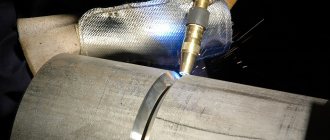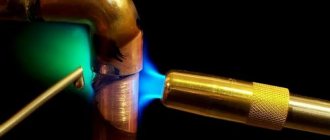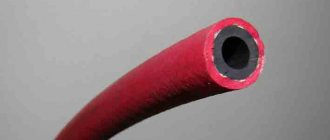Home / Consumables
Back
Reading time: 3 min
1
2375
The welding wire used in acetylene gas welding is made by many manufacturers.
The products are presented in the form of filler rods and drawn wire, with or without a sheath of non-ferrous alloys, and metal granules.
Welding material is available in the following types:
- activated - reduces spattering, improves seam quality;
- powder - allows you to obtain a seam with a composition similar to the elements being welded;
- solid section - used in the form of filler rods.
The materials allow you to work with any type of metal.
However, the diameter of the wire must not only correspond to the thickness of the product being welded, but also be similar to its chemical composition.
The material examines some types of welding material used in the process of welding and surfacing of products made of ferrous and non-ferrous metals.
- Wire for steel
- Welding of aluminum and copper alloys
- Welding cast iron
- Nuances of use
Wire for welding steels
Most often, filler wire is purchased in stores for gas welding of steels. Note that this wire is manufactured according to the same standards as for arc welding. Therefore, there is no difference between wire for gas and for RDS welding. For ordinary welding of most types of steel, wire made from low-carbon and alloy steel is used. For welding critical and especially critical structures, it is recommended to use low-alloy wire.
If you need to achieve the best quality of welds or surfacing seams, then use manganese and silicon-manganese wires. These include brands Sv-08GS, Sv-08GA, Sv-08G2S, Sv-10G2. When using these brands, the seams are strong and reliable. They are resistant to mechanical damage.
When working with low-alloy steel, purchase the same low-alloy wire, but with chromium content. The resulting seams have a high tensile strength. But when welding high-alloy steel, wire should be selected with a similar chemical composition.
Welding wire marking
To choose the right additive, you need to know in advance what type of work you plan to perform. The fact is that each type of wire is designed for a specific job. Cutting metal is unlikely to be possible with consumables designed for semi-automatic welding.
Plus, the consumables differ in diameter, which is selected depending on the thickness of the workpiece. The thicker the parts being welded, the larger the diameter of the additive should be. And it varies over a wide range of values: from 0.8 to 12 mm. Most often, welders require relatively thin rods - about 3 millimeters.
When planning to weld two titanium workpieces, it is logical to assume that a specialist uses the appropriate titanium welding wire. It is important to know its composition. After all, various additives are often added to the wire; The level of alloying also varies. The quality of the weld depends on the compatibility of the base material and the additive. The more homogeneous their composition, the better for the final result.
All information is “hardwired” into the labeling. To determine what a particular symbol means, it is enough to consider a simple example. The abbreviation “Sv-06Х19Н9Т” denotes one of the most popular types of additive. The first two letters “Св” indicate that the material is intended only for welding - cutting or other types of work cannot be performed with it. That is, the first two letters indicate the type of consumable. In addition to welding wire, there are surfacing wires (“Np”) and flux-cored wires (“Pp”).
The next two numbers indicate the percentage of carbon. 06 is six hundredths of a percent (0.06%) of the total mass of the material. Below is information about the inclusions and their shares. The letter “X” informs that the additive contains chromium, and its amount is “19” - 19%. The additive contains 9% nickel (“N”), but how much titanium (“T”) is not indicated. The fact is that if the amount of inclusion is less than 1%, then such data is not included in the labeling. That is, there is less than one percent titanium in the wire.
It remains to remember what certain symbols mean that are used in wire markings:
- G – manganese;
- D – copper;
- M – molybdenum;
- C – silicon;
- C – zirconium;
- F – vanadium;
- Yu – aluminum.
Wire for welding aluminum and its alloys, copper and its alloys
Aluminum welding wire, as well as wire made of aluminum alloys, is manufactured in accordance with GOST No. 7871-75. To work with aluminum, we recommend using the brands Sv-AK-5, Sv-A1 and Sv-AMts. The composition of the wire should be similar to the composition of the part.
For welding copper and copper alloys, wire manufactured according to the GOST standard No. 16130-90 is used. We recommend using wire grades M1 or MSr1. You can also use filler rods of the M1r and M3r brands.
To work with other non-ferrous metals (for example, bronze or brass), use wire with the same composition as the part itself. In this case, the brand of wire is not so important.
Requirements
Stainless steel welding wire must meet all the requirements of GOST 2246-70. When welding, the chemical composition must match the composition of the materials being joined. The melting temperature of the welding wire is lower than or equal to the temperature of the workpieces being welded.
Stainless steel welding wire QUATTRO ELEMENTI 770-407. Photo 220Volt
Features of application
Before use, welding wire for gas welding with acetylene (or any other flammable gas) must be thoroughly cleaned of dirt, oil, traces of corrosion, paint, scale, etc. Form the seams slowly and evenly. Avoid splashing metal while welding. After cooling, the seam bead should be smooth and uniform in appearance. The presence of defects (pores, cracks, slag inclusions, etc.) is not allowed. Watch out for refractory oxides; they should not get into the weld pool. And most often they enter the welding zone with filler material. The oxides themselves are formed due to the reaction of nitrogen with oxygen. Their melting point is higher than that of the base metal. For this reason, the seams become uneven and of poor quality.
Kinds
The main technological process where stainless steel wire is used is semi-automatic in an atmosphere of protective gases. To improve process parameters, it can be coated with copper, i.e. be copper-plated (! not to be confused with copper wire). It is used as an additional material in argon arc welding with a non-consumable electrode. Using a gas burner, it is applied to the surface in the form of surfacing.
Useful video
Classification
The types of welding wire are varied. They differ in the direction of application, surface condition, structure, and internal composition of chemical elements.
Brands of welding wire for solving a wide range of production problems are designated by a combination of the letters OH (general purpose) or OK (general quality).
These products are widely used in welding and for the manufacture of various wire products. Ordinary wire is used as a structural and knitting material.
Special-purpose grades are used when welding complex pipes with forced formation of a seam, carrying out the process under water, and under other specific circumstances.
The surface condition of the filler material also varies: with and without copper coating. Copper-plated wire protects the seam from the oxidative action of the environment, promotes stable arc formation, and is most often used in gas welding technology.
In general, gas welding wire is produced using the same technologies as products for electric arc welding.
Based on their internal structure, welding wire is divided into three categories:
- solid with a uniform cross-section;
- powder (tubular);
- activated.
Solid section products are welding wires for semi-automatic and fully automated processes. Filler rods and electrodes are made from it.
The powder product is a tube containing from 15% to 40% powder (flux, or metal particles) inside. The structure of activated wire is similar to that of tubular products. The specificity lies in the reduced content of powder filler. Its mass fraction does not exceed 7%.
Where is flux cored welding wire used?
This type is used for connecting metal products. They contain low-alloy, medium-carbon and carbon steel. Another component in the installation process is the absence of a gaseous medium.
Another name for flux-cored wire for welding is fleece. It is based on the fact that not the entire body is made of a metal alloy. The inner container is filled with a special powder.
The main advantage of this material is considered to be high-quality seams. During operation, a powerful arc is formed, which allows you to fix iron workpieces.
Such wire is divided into five categories:
- Organic;
- Rutile fluorite;
- Fluorite – carbonate;
- Rutile;
- Fluorite.
Novice welders can sometimes confuse this model of consumable with steel welding wire.
When choosing consumables, it is necessary to take into account the diameter of the welding wire and the thickness of the iron structure.
Characteristics of steel wire
This type of product can be used in any field. Most often it is chosen for construction and industrial work. It can be classified according to several criteria.
The main ones are strength, cross-section, diameter and alloy used for production.
Today, a large number of varieties of such material are known. In turn, they are divided into:
- Welding;
- Spring;
- Reinforced;
- Ropeway;
- Prickly.
The diameter depends on the type of consumable. Popular brands are divided into several types:
- For working with low carbon steels;
- For fixing medium and low alloy alloys;
- For welding high-alloy substrates.
Most steel consumables can be copper plated. As a result, it helps protect the weld surface from further oxidation and also improves the quality of work.
Recommendations for use
Stainless steel wire 308LSi (0.8 mm; cassette 15 kg) BARS. Photo VseInstruments.ru
- Clean the welded edges with a wire brush or grinder. Degrease.
- Set the required gap according to the regulatory documentation.
- Grab it.
- Select shielding gas . Pure carbon dioxide produces a lot of spatter. It is better to use it in a mixture with argon.
- When welding with shielding gas, it is recommended to keep the arc as short as possible. This will prevent the formation of so-called hot cracks. The shape of the seam with such an arc does not contribute to their occurrence.
- The melting point of stainless steel is quite high (about 1800°C), therefore an increased welding current is required . Under such conditions, there is a high probability of burning through the material, especially thin sheets. The use of the pulse welding method makes it possible to control this process.
Manufacturers
Quite a lot of enterprises that produce consumables specialize in the production of stainless steel welding wire, some of them.
ESAB is a Swedish company whose activities are based on innovative solutions in all areas of welding technology. Over the 110 years of its activity, it has become a world leader in the welding industry, producing not only stainless, but also polished, copper-plated, aluminum and other types of wire.
Stainless steel welding wire ESAB OK Autrod 316LSi, 0.8mm., 5.0kg. Photo Welding Technologies
OLIVER has been on the welding technology market since 1993. The company has kept pace with evolving trends and continues to strive to look into the future.
LINCOLN ELECTRIC is an American company founded in 1895, which released the world's first single-user welding machine in 1911. Has its own separate enterprise for the production of welding wires.
DEKA is a Chinese manufacturer offering a wide selection of stainless steel wires at affordable prices.
